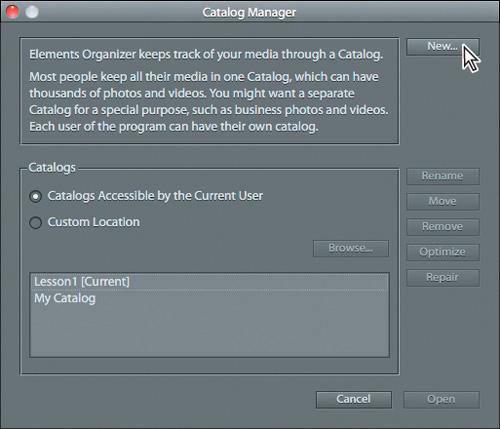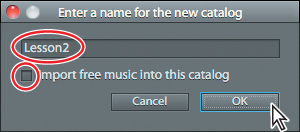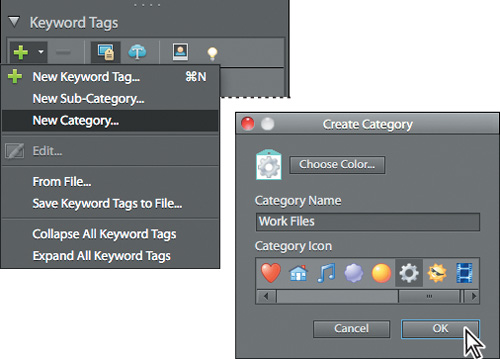As you capture more and more images with your digital camera, it becomes increasingly important that you have effective ways to organize and manage your pictures on your computer so that those valuable memories are always accessible.
Adobe Photoshop Elements makes it easy to import your photos and other media files from a variety of sources and provides an array of powerful tools for sorting and searching your collection.
This lesson will get you started with the essential skills you’ll need to import images and keep track of your growing photo library:
Opening Adobe Photoshop Elements 9 in Organizer mode
Creating a catalog for your images
Importing images from folders on your computer
Importing photos from a digital camera
Switching between viewing modes in the Media Browser
Working in the Date and Folder Location views
Creating, organizing, and applying keyword tags
Searching for files by keyword
Finding and tagging faces in your photos
You’ll probably need between one and two hours to complete this lesson.

Import files to your catalog, and then explore a variety of ways to view and sort them. Learn how tagging and rating your photos can help you find just the pictures you want, just when you want them—easily and quickly. Once they share a keyword tag, a group of related photos can be retrieved with a single click, no matter how big your catalog, or across how many folders those images are scattered.
For the exercises in this lesson you’ll be working in the Elements Organizer component of Adobe Photoshop Elements.
Start Photoshop Elements by doing one of the following:
On Windows, either double-click the shortcut on your desktop, or choose Start > All Programs > Adobe Photoshop Elements 9.
On Mac OS, either click the Photoshop Elements 9 icon in the Dock, double-click the application icon in the Applications folder, or choose Photoshop Elements 9 from the Apple > Recent Items > Applications menu.
Note
Before you start working on this lesson, make sure that you’ve installed the software on your computer from the application CD (see the Photoshop Elements 9 documentation) and that you have correctly copied the Lessons folder from the CD in the back of this book onto your computer’s hard disk (see “Copying the Classroom in a Book files” on page 2).
In the Welcome screen, click the Organize button at the left.
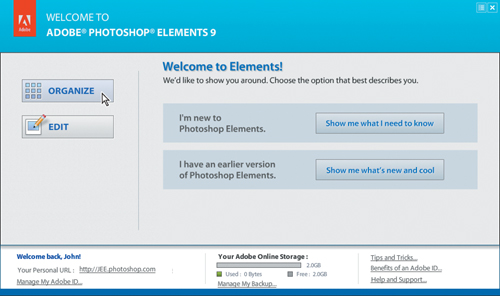
Photoshop Elements stores information about your images in a library catalog file, which enables you to conveniently manage the photos on your computer from within the Organizer.
A catalog can include digital photographs, video and audio files, PDF documents, scans, and any presentations or layouts you might create in Photoshop Elements.
When you organize your files in Elements Organizer, all your work is recorded in the catalog. A single catalog can efficiently handle thousands of files, but you’re free to create as many catalogs as you wish to suit the way that you prefer to work.
To begin this lesson you can create a new catalog so that you won’t confuse the practice files for this lesson with files for the other lessons in this book.
The new Lesson2 catalog is loaded in the Organizer. If you’re ever unsure of which of your catalogs you’re working with, remember that the name of the currently active catalog will appear in a tooltip when you hold the pointer over the Organizer icon (![]() ) at the upper left of the workspace window, and is also displayed in the lower left corner of the Organizer workspace.
) at the upper left of the workspace window, and is also displayed in the lower left corner of the Organizer workspace.

The Elements Organizer provides a workspace where you can view, sort and organize your media files. Before you print your photos, use them in projects, burn them to CD or DVD-ROM, or share them by e-mail or on the Web, the first step is to assemble them in the Organizer. In the following exercises you’ll import the images for this lesson into your new catalog using a variety of different methods.
Perhaps the most direct and intuitive way to bring photographs and other media into the Organizer catalog is to use the familiar drag-and-drop method.
Minimize the Organizer by clicking the Minimize button (
 ) at the right of the Organizer menu bar, or simply click the Organizer application button on the Windows taskbar.
) at the right of the Organizer menu bar, or simply click the Organizer application button on the Windows taskbar.
Open the My Computer window in Windows Explorer; either double-click a shortcut icon on your desktop, or choose My Computer from the Start menu.
Locate and open the Lessons folder that you copied to your hard disk (see “Copying the Classroom in a Book files” on page 2). Open the Lesson02 folder, and then the sub-folder named Import.

Inside the Import folder there are three sub-folders: drag the BATCH1 subfolder and hold it over the Organizer application button on the Windows taskbar.
Wait until the Organizer becomes the foreground application; then, drag the BATCH1 folder onto the Media Browser pane in the Organizer and release the mouse button. Skip to page 38: Importing attached keyword tags.
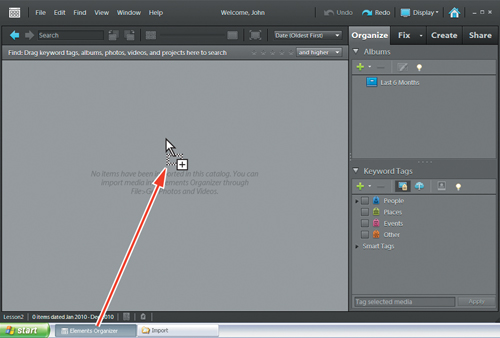
There are several ways to switch to the Finder on Mac OS. For this exercise, we’ll use the Application Switcher. Hold down the Command key; then, press and release the Tab key. Continuing to hold down the Command key, click the Finder icon; then, release the Command key
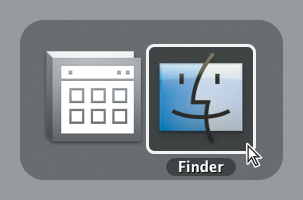
In the Finder, press Command+N to open a new Finder window.
Navigate to and open the Lessons folder that you copied to your hard disk (see “Copying the Classroom in a Book files” on page 2). Open the Lesson02 folder, and then the sub-folder named Import.
Inside the Import folder are three sub-folders: BATCH1, BATCH2, and BATCH3. If necessary, move the finder window enough to see the Elements Organizer workspace behind it; then, drag the BATCH1 subfolder onto the Media Browser pane and release the mouse button.

Photoshop Elements briefly displays a dialog box while searching inside the BATCH1 folder for files to import; then, the Import Attached Keyword Tags dialog box opens. Click the Organizer workspace to bring it back to the front.
If your files have already been tagged with keywords, the Import Attached Keyword Tags dialog box will appear, whichever method you use to bring your photos into Elements Organizer. The Import Attached Keyword Tags dialog box gives you the opportunity to specify which tags you wish to import with your images.
In the Import Attached Keyword Tags dialog box, click Select All; then, click OK.

The Getting Media dialog box appears briefly as the Organizer imports the images from your BATCH1 folder. If a message appears telling you that only the newly imported items will be visible in the Media Browser, click OK. Thumbnails of the eight images you imported appear in the Media Browser.
Each thumbnail is displayed with an orange tag icon indicating that the image has keywords attached.
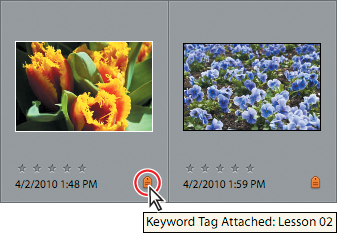
Hold the pointer over the tag icon at the lower right of any image cell in the Media Browser to see a tooltip listing attached keywords.
In the Keywords panel to the right of the Media Browser, click the small triangle to expand the Imported Keyword Tags category; you can see that the newly imported Lesson 02 tag is nested inside.
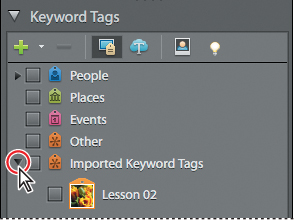
In this exercise you’ll use a menu command to import files to the Organizer from a known folder on your hard disk.
Choose File > Get Photos And Videos > From Files And Folders. In the Get Photos And Videos From Files And Folders dialog box, navigate to your Lesson02 folder, open the Import folder, and then the BATCH2 folder.
To see preview thumbnails, and information about the files you are about to import, do one of the following:
On Windows, hold the pointer over an image file in the BATCH2 folder to see a tooltip with detailed information about the photo; select the file to see a thumbnail image in the Preview pane.

On Mac OS, click the Column View button (
 ) at the top left of the dialog box. Select any of the images in the BATCH2 folder to see a preview together with detailed information about the file.
) at the top left of the dialog box. Select any of the images in the BATCH2 folder to see a preview together with detailed information about the file.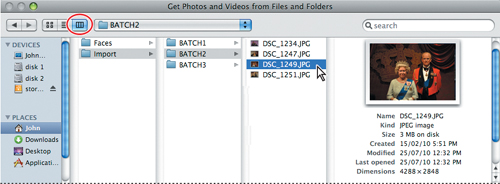
Select all four images and ensure that the Automatically Fix Red Eyes option (Windows and Mac OS) and Automatically Suggest Photo Stacks (Windows only) are disabled, and then click Get Media.
Select the keyword “Lesson 02” in the Import Attached Keyword Tags dialog box. An asterisk (*) beside the selected keyword indicates that by default the new batch of images will pick up the existing Lesson 02 keyword tag.
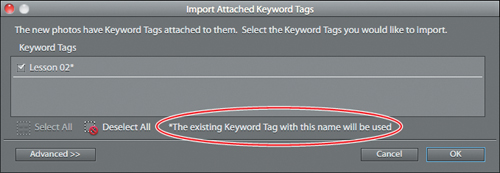
Click the Advanced button in the lower left of the dialog box. Now you have the option to either use the existing tag of the same name or to type a new one. For now, leave the settings unchanged. Click the Reset To Basic button; then click OK. Click OK to dismiss any other alert dialog box.
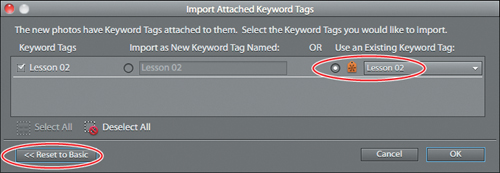
The term “red eye” refers to the phenomenon common in photos taken with a flash, where the subject’s pupils appear red instead of black. This is caused by the flash reflecting off the retina at the back of the eye.
In most cases, Photoshop Elements can successfully remove the red eye effect automatically during the import process, saving you the effort of further editing.
If you don’t see file names displayed below the thumbnails in the Media Browser, choose View > Show File Names.
Double-click the image DSC_1234.jpg to see the enlarged single image view. The red eye effect is very noticeable in the eyes of the young girl in this photo.
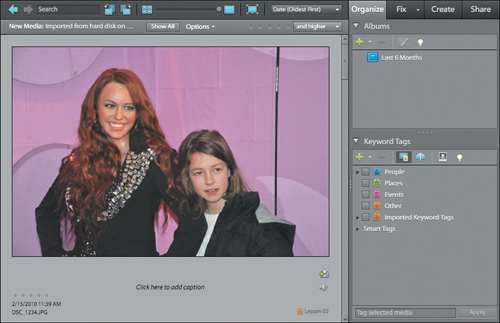
Double-click the image to return to the thumbnail display in the Media Browser. Make sure that the image DSC_1234.jpg is still selected; then, choose Edit > Delete From Catalog. In the confirmation dialog box, make sure that the option Also Delete Selected Item(s) From The Hard Disk is disabled, and then click OK.
Choose File > Get Photos And Videos > From Files And Folders. In the Get Photos And Videos From Files And Folders dialog box, navigate to your Lesson02 folder, open the Import folder, and then the BATCH2 folder.
Select the image DSC_1234.jpg, activate the Automatically Fix Red Eyes option, and then click Get Media. Photoshop Elements briefly displays a progress bar in the Getting Media dialog box as the image is processed and imported.

In the Import Attached Keyword Tags dialog box, select the Lesson 02 tag, and then click OK. Click OK to dismiss any other alert dialog box.
A thumbnail of the newly imported image appears in the Media Browser. Photoshop Elements has grouped the edited photo with the un-edited original in a Version Set. You can identify a Version Set by the badge in the upper right corner of the thumbnail and the label below the thumbnail. The edited version of the photo is displayed as the top image in the Version Set; the filename has been extended to indicate that the image has been edited.
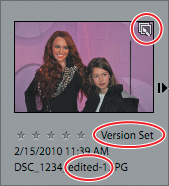
Tip
Click the arrow at the right of the thumbnail once to expand the Version Set, and again to collapse it. You’ll learn more about working with Version Sets in Lesson 3.
Double-click the top image in the Version Set, DSC_1234_edited-1.jpg, to see the enlarged single image view. Photoshop Elements has successfully removed the red eye effect.

Note
For some images, the automatic red eye fix will not be so effective; more tools and techniques for correcting the effect are discussed in Lesson 7.
Click Show All at the top of the Media browser to see all twelve images in your Lesson2 catalog.

This method is useful when you’re not sure exactly where on your hard disk you’ve stashed your photographs and other media files over the years. You might run a search of your entire hard disk or just your My Documents folder. For this exercise, you’ll limit the search to just a small branch of your folder hierarchy.
In the Organizer, choose File > Get Photos And Videos > By Searching. Under Search Options in the Get Photos And Videos By Searching For Folders dialog box, choose Browse from the Look In menu.
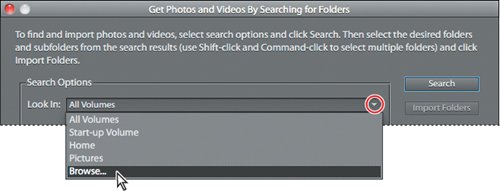
In the Browse For Folder / Select Folder For Search dialog box, locate and select your Lessons folder, and then click OK.
Under Search Options in the Get Photos And Videos By Searching For Folders dialog box, make sure the Automatically Fix Red Eyes option is disabled; then, click the Search button located at the upper right of the dialog box.
The Search Results box lists all folders inside the Lessons folder. The preview pane at the right shows thumbnails of the contents of a selected folder. Select the Lessons/Lesson02/Import/BATCH3 folder and click Import Folders.
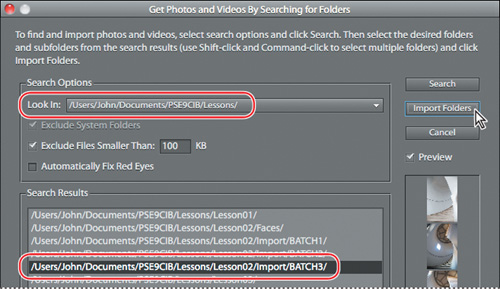
In the Import Attached Keyword Tags dialog box, click Select All, and then click OK. Click OK to close any other alert dialog box. Click the Show All button above the Media Browser to see all sixteen images in your Lesson2 catalog.
If you have a digital camera or memory card at hand with your own photos on it, you can step through this exercise using those images. Alternatively, you can simply follow the process in the book without performing the exercise yourself, or skip to the next section of this lesson and return to this exercise when you are prepared.
Connect your digital camera or card reader to your computer, following the manufacturer’s instructions.
If you’re working on Mac OS, skip to step 3. On Windows, the Auto Play dialog box may appear. You could choose the option Organize And Edit Using Adobe Elements Organizer 9, but for the purposes of this lesson, simply click Cancel to dismiss the dialog box. If the Photo Downloader dialog box appears automatically, you can skip to step 4; otherwise, continue to step 3.
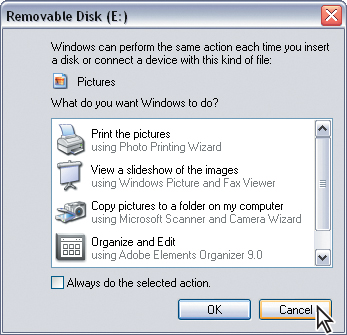
Choose File > Get Photos And Videos > From Camera Or Card Reader.

In the Photo Downloader dialog box, choose the name of your connected camera or card reader from the Get Photos From menu.
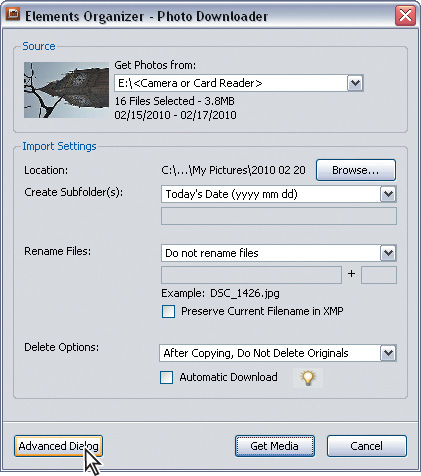
Accept the default target folder listed beside Location, or click Browse / Choose to designate a different destination for the imported files.
From the Create Subfolder(s) menu, choose Today’s Date (yyyy mm dd) as the folder name format; the Location path reflects your choice.
Choose Do Not Rename Files from the Rename Files menu. From the Delete Options menu, choose After Copying, Do Not Delete Originals. If you’re working on Windows, deactivate the Automatic Download option.
Click the Advanced Dialog button.
In advanced mode, the Photo Downloader Dialog displays thumbnail previews of all the photos on your camera’s memory card, and also offers options for processing, tagging, and grouping your images during the import process.
If there is a photo on your camera that you don’t wish to import, click the check box below its thumbnail to remove the check mark. The un-checked photo will be excluded from the selection to be imported.
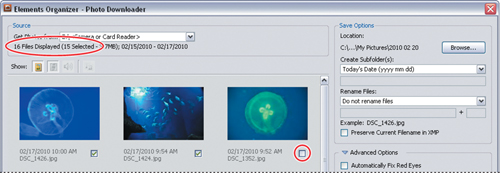
If you see a photo that needs to be rotated, select its thumbnails and click the appropriate Rotate button in the lower left corner of the dialog box.

Under Advanced Options, make sure that the Automatically Fix Red Eyes, Make ‘Group Custom Name’ A Tag, and Import Into Album options are disabled. On Windows, disable Automatically Suggest Photo Stacks.
Click Get Media.
The selected photos are copied from the camera to the specified folder on your hard disk. By default, imports from a camera are copied to your My Pictures / Pictures folder.
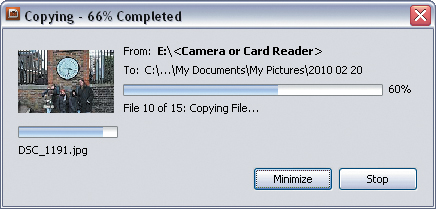
In the Files Successfully Copied dialog box, click Yes.
Photoshop Elements briefly displays a progress bar in the Getting Media dialog box as the photos are imported. Click OK to close any other alert dialog box.
The imported photos appear in the Media Browser, already rotated where specified.
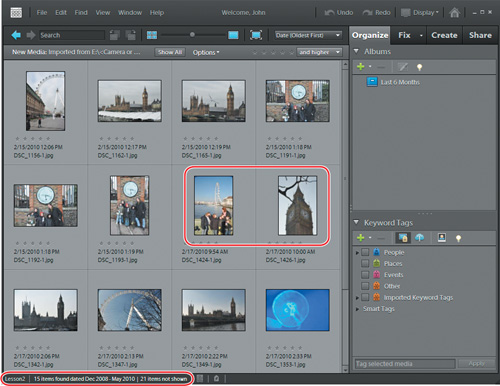
The name of the active catalog is displayed in the lower left corner of the Organizer. You can also see a count of the items currently shown in the Media Browser and an indication of the range of their capture dates. If you apply a search, these details will change to describe the search results.
Watched folders are not supported for Mac OS; if you’re working on Mac OS, you can skip to “Viewing photo thumbnails in the Organizer” on the next page.
On Windows, you can simplify and automate the process of keeping your catalog up to date by using watched folders. Designate any folder on your hard disk as a watched folder and Photoshop Elements will automatically be alerted when a new file is placed in (or saved to) that folder. By default, the My Pictures folder is watched, but you can set up any number of additional watched folders.
You can either choose to have any new files that are detected in a watched folder added to your catalog automatically, or have Photoshop Elements ask you what to do before importing the new media. If you choose the latter option, the message “New files have been found in Watched Folders” will appear whenever new items are detected. Click Yes to add the new files to your catalog or click No to skip them.
In this exercise you’ll add a folder to the watched folders list.
Choose File > Watch Folders.
Under Folders To Watch in the Watch Folders dialog box, click Add, and then browse to your Lesson02 folder.
Select the Lesson02 folder and click OK.
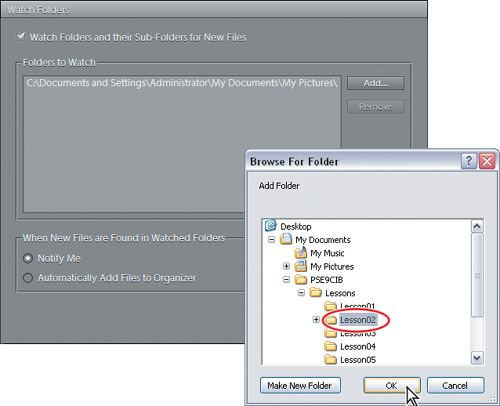
The Lesson02 folder now appears in the Folders To Watch list. To stop a folder from being watched, select it in the list and click Remove.
Ensure that the Notify Me option is activated, and then click OK to close the Watch Folders dialog box.
This concludes the portion of this lesson concerned with importing files into your catalog. You’ll learn more ways to bring media into Photoshop Elements—together with time-saving techniques for sorting and managing your files even as you import them—in Lesson 3, “Advanced Organizing.”
In the Organizer, there are several ways to view the images in your catalog. You can switch between the various viewing modes to suit different stages in your workflow or to make it easier and more efficient to perform specific organizing tasks.
Up to this point, you’ve been working in the default Media Browser view: the Thumbnail View, where your images are arranged by capture date and time. You can reverse the display order by choosing either Date (Oldest First) or Date (Newest First) from the menu to the right of the Thumbnail Size slider just above the Media Browser pane.
Let’s look at some of the other display options in the Organizer.
Click the Show All button if it’s visible at the top of the thumbnail view; then, use the Thumbnail Size slider just above the Media Browser pane to reduce the size of the thumbnails so that you can see all the images in your Lesson2 catalog.
Click the Display button (
 ) near the upper right corner of the Organizer window, and then choose Import Batch from the menu to see the thumbnails organized by their separate import sessions.
) near the upper right corner of the Organizer window, and then choose Import Batch from the menu to see the thumbnails organized by their separate import sessions.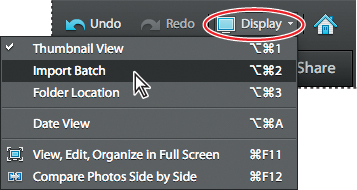
In the Import Batch view, a divider bar marked with a film canister icon (
 ) and an import session date separates each group of thumbnails. Click any of the divider bars to select all of the images that were imported in that session.
) and an import session date separates each group of thumbnails. Click any of the divider bars to select all of the images that were imported in that session.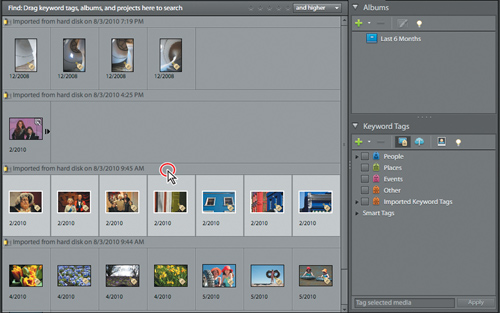
Choose Window > Timeline. The timeline shows a series of bars representing the separate import sessions that account for all the images in this catalog.
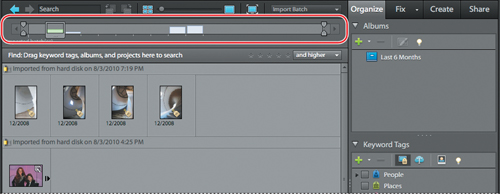
The varied height of the bars indicates that each import batch contains a different number of images. In this illustration, the timeline represents activity spread across a single day. Your bars may be arranged differently, especially if you’ve completed the preceding exercises over an hour or less.
Choose Edit > Deselect, and then drag the Thumbnail Size slider above the Media Browser to increase the size of the thumbnails until you see only a subset of the images in your Lesson2 catalog.
Click each of the bars in the timeline in turn. As you click, the view in the Media Browser jumps to the corresponding import batch; the first image in the batch is surrounded by a green border and its capture date flashes.
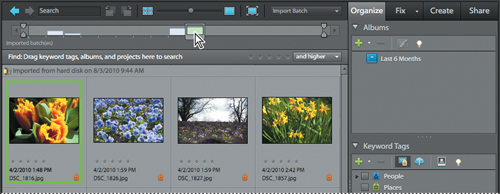
Choose Window > Timeline once more to hide the timeline from view.
Select any image in the Media Browser; then, click the Display button (
 ) near the upper right corner of the Organizer window and choose Folder Location to see the photo’s location in the folder hierarchy on your computer. The bar across the top of the Media Browser now displays a Managed Folder icon (
) near the upper right corner of the Organizer window and choose Folder Location to see the photo’s location in the folder hierarchy on your computer. The bar across the top of the Media Browser now displays a Managed Folder icon ( ) and the path-name of the folder containing your selected image.
) and the path-name of the folder containing your selected image.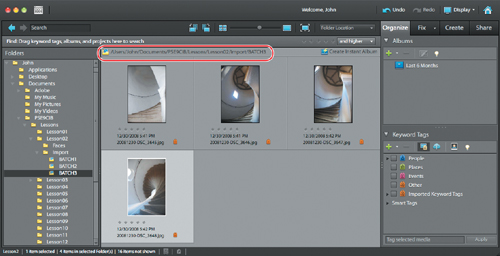
In the Folders panel at the left of the Media Browser, you can see at a glance which folders contain images that have been imported to the Lesson2 catalog; these folders are marked with the Managed Folder icon (
 ). On Windows, you’ll also be able to spot your watched folders: look for the Watched Folder icon (
). On Windows, you’ll also be able to spot your watched folders: look for the Watched Folder icon ( ).
).The Folder Location view becomes more useful the larger your photo library grows. At this point, you’re working with a catalog that contains very few images, so it may not be instantly apparent that a single folder may contain multiple import batches and a single import batch may include files from multiple folders.
In the Folders panel, drag the selected image from the Media Browser to the PSE9CIB folder. The Lesson2 catalog is updated to record the new location of the moved photo; in the Folders panel, the PSE9CIB folder is now marked with a Managed Folder icon. Choose Edit > Undo Move.
In the Folders panel, you can move the folders on your hard disk in the same way, making it easy to manage your photo library without leaving the Organizer.
Right-click / Control-click any of your managed folders and note the commands available in the context menu.
Click the header bar across the top of the Media Browser to select all the photos in the folder you’re viewing.
Choose Window > Timeline. This time, the bars you see in the timeline represent the three folders containing the images in this catalog. Click each bar in the timeline in turn, the corresponding source folder is highlighted in the Folders panel hierarchy.
Choose Window > Timeline once more to hide the timeline from view, and then choose Edit > Deselect. In preparation for the next exercise, click the BATCH1 folder in the Folders panel; then, click the Back To Previous View button (
 ) at the upper left of the Organizer window to return to the Thumbnail View.
) at the upper left of the Organizer window to return to the Thumbnail View.
The Date View can be a great way to organize and access your images, particularly once you are working with a large collection of photos that span a number of years.
Click the Display button (
 ) near the upper right corner of the Organizer window and choose Date View from the menu.
) near the upper right corner of the Organizer window and choose Date View from the menu.
If the Date View opens to display other than a full year calendar, click the Year view button (
 ) below the calendar display.
) below the calendar display.You can see at a glance that your Lesson2 catalog contains photographs taken on four separate dates during 2010. Dates shown in red are holidays; in the Date View pane of the Organizer preferences you can specify which holidays are marked.
Click May 24, 2010 on the calendar. A thumbnail preview of the first image captured on that date appears at the right of the Organizer window. An image count at the lower left of the preview indicates that there are four files in your catalog that share this creation date.
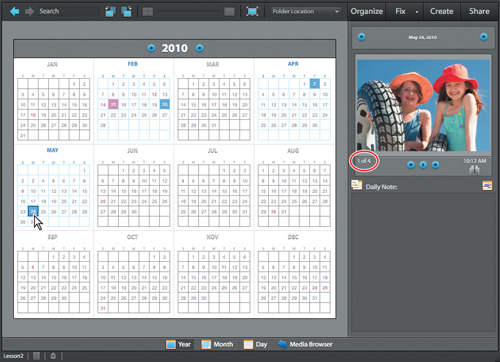
Click the Find This Photo In The Media Browser button (
 ) below the preview thumbnail to see the currently previewed photo in the Media Browser where it can be selected, ready for action.
) below the preview thumbnail to see the currently previewed photo in the Media Browser where it can be selected, ready for action.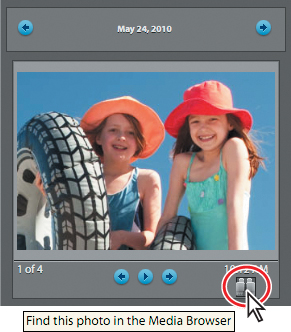
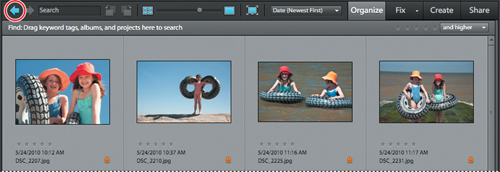
In the Media Browser, click the Back To Previous View button (
 ) near the upper left corner of the Organizer window to return to the Date View.
) near the upper left corner of the Organizer window to return to the Date View.Click the Month view button (
 ) below the calendar; then, click the month name at the head of the calendar page and choose February from the months menu. If you wished to move one month at a time, you could simply click three times on the Previous Month button to the left of the month name.
) below the calendar; then, click the month name at the head of the calendar page and choose February from the months menu. If you wished to move one month at a time, you could simply click three times on the Previous Month button to the left of the month name.
The February page opens with the 15th selected, that being the earliest date in February for which there are photos in your catalog. Click in the Daily Note box at the right of the calendar page and type A brush with fame! Click February 15th; a note icon appears on the thumbnail to indicate a note for that day.
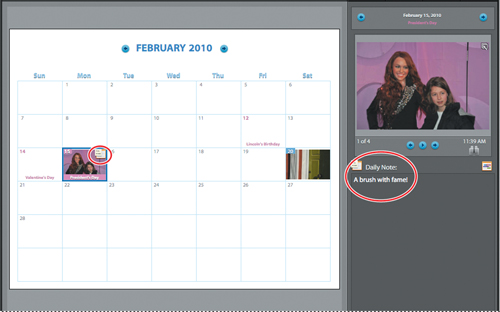
Use the Next Item On Selected Day button (
 ) under the preview image to see the other photographs captured on the same date.
) under the preview image to see the other photographs captured on the same date.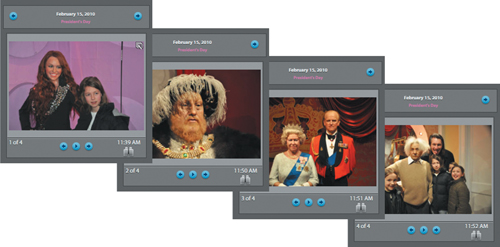
Click the Start Automatic Sequencing button (
 ) under the preview image to view all the photos taken on the same day as a mini slide show.
) under the preview image to view all the photos taken on the same day as a mini slide show.Now that you know how to access photos via the calendar you’ll be able to return and use the Date View whenever you wish, but for the remainder of this lesson you’ll work with the Media Browser in Thumbnail view.
Either click the Back To Previous View button (
 ) near the upper left corner of the Organizer window or click the Media Browser button below the calendar page. You could also choose Media Browser from the Display menu.
) near the upper left corner of the Organizer window or click the Media Browser button below the calendar page. You could also choose Media Browser from the Display menu.
Most of us find it challenging to organize our files and folders efficiently. It can be so easy to forget which pictures were stored in what folder—and so tedious when you’re forced to examine the contents of numerous folders looking for the files you want. The Elements Organizer offers an array of powerful and versatile tools for organizing, sorting, and searching that make all that frustration a thing of the past.
Earlier in this lesson you learned that even during the import process you can search your computer for the files you want to bring into your catalog. The next set of exercises will demonstrate how just a little time invested in applying ratings and tags to the files you import can streamline the process of locating and sorting your pictures, regardless of how many image files you have or where they are stored.
Applying keywords to your photos and grouping those tags in categories can make it quick and easy to find exactly the images you’re looking for. With a single click you can rate each photo from one to five stars, adding a simple way to narrow a search. In this exercise, you’ll apply a rating to one of the images you imported into your Lesson2 catalog, and then tag it with a keyword from the default set.
Make sure that the options Details and Show File Names are activated in the View menu.
In the Media Browser, move the pointer slowly from left to right over the stars beneath the thumbnail image of the girl on the sand dune. When you see four yellow stars, as in the illustration below, click to apply that rating.
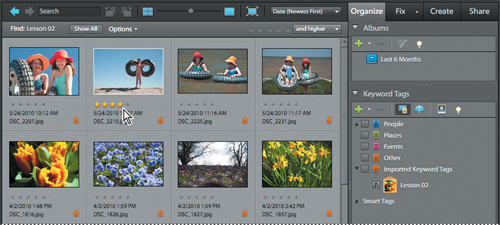
To find images based on the ratings you’ve assigned, use the stars and the adjacent menu located at the right end of the Find bar above the thumbnail display. For this example set the search criteria at 3 stars and higher. Only the image with the 4-star rating is displayed in the Media Browser.

Click the Show All button in the Find bar.
In the Keyword Tags panel, click the arrow beside the People category to expand that category so that you can see the two nested sub-categories “Family” and “Friends.”
Drag the Family keyword tag to the thumbnail of girl in the sand dune.

Collapse the People keyword tag category, and then Ctrl-click / Command-click to select the other three images of girls playing at the beach.
Click in the text box at the bottom of the Keywords Tags panel and type the letter f. As you type a list of the existing keywords starting with f appears; choose Family, and then click Apply. The tag is applied to the three images you selected in the Media Browser.

Rest the pointer for a second or two over a tag icon beneath the thumbnail of any of your newly tagged photos; a tooltip message appears identifying the keyword tags that are attached to that image file.
Note
In the Media Browser, the keyword tag icon or icons that you see below the thumbnails will vary in appearance depending on the size at which the thumbnails are displayed. If the thumbnail size is very small, multiple color-coded tags may display as a single generic (beige) tag icon.???
In the Keyword Tags panel, click the triangle to expand the People keyword tags category once more. Click the empty Find box beside the Family sub-category. The Media Browser is immediately updated to display only the four images to which you assigned the Family tag.
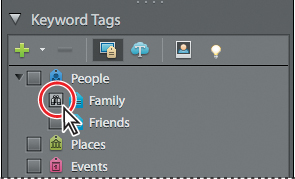
Click the Find box beside the Family tag again to clear the search. Once more the Media Browser displays all sixteen images in your Lesson2 catalog.
It’s easy to add or delete new keyword tag categories and sub-categories in the Keyword Tags panel to help you group and organize your keyword tags.
At the top of the Keyword Tags panel, click the Create New Keyword Tag, Sub-category, Or Category button (
 ) and choose New Category from the menu.
) and choose New Category from the menu.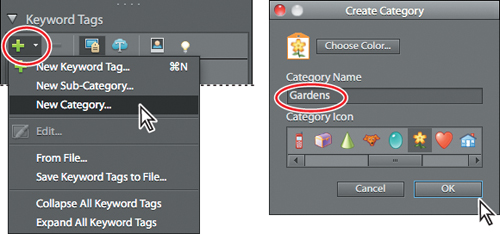
In the Create Category dialog box, type Gardens as the category name; then scroll the Category Icon menu and select the flower icon. Click OK.
In the Keyword Tags panel, expand the People category if necessary; then click to select the Family sub-category. Click the Create New button (
 ) and choose New Sub-Category from the menu.
) and choose New Sub-Category from the menu.In the Create Sub-Category dialog box, type Kids as the new Sub-Category name. Ensure that Family is selected in the Parent Category or Sub-Category menu and click OK. Your new keyword tag category and sub-category have become part of this catalog.
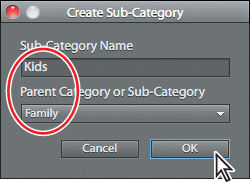
You can assign keyword categories to (or remove them from) several files at once.
In the Media Browser, click any of the six photos featuring children; then hold down the Ctrl / Command key and click to add the other five to the selection.
Click in the text box in the header of the Keywords Tags panel and type the letter k; choose Kids and click Apply. The tag is applied to the selected images.
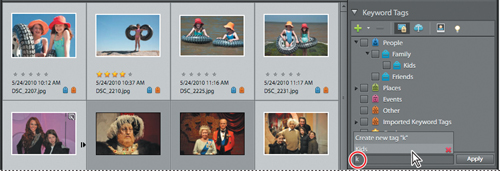
Leaving the same six images selected, drag the Garden keyword tag to one of the un-selected images of flowers. Selecting the thumbnail or deselecting the other thumbnails is not necessary; the keyword tag is applied to just this picture.
Choose Edit > Deselect, and then Ctrl-click / Command-click to select the three un-tagged flower photos. Drag your multiple selection onto the Garden tag in the Keyword Tags panel. The keyword tag Garden is applied to all three images at once.
Select the image of the young girl to which you applied a 4-star rating earlier in the lesson. Choose Window > Properties to open the Properties panel, and then click the Keyword Tags tab (
 ) to see which keyword tags are attached to this image.
) to see which keyword tags are attached to this image.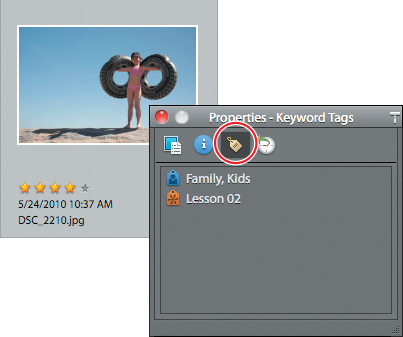
Remove the Family tag from the image by doing one of the following:
In the Properties panel, right-click / Control-click the listing Family, Kids, and then choose Remove Family Sub-Category Keyword Tag.
In the Media Browser, right-click / Control-click the thumbnail in the Media Browser and choose Remove Keyword Tag > Family from the context menu.
Right-click / Control-click the tag icon beneath the thumbnail itself, and then choose Remove Family Sub-Category Keyword Tag from the menu.

Close the Properties panel by clicking the Close button—in the upper right corner of the panel on Windows, at the upper left on Mac OS—or by choosing Window > Properties again.
In the last exercise you created new keyword categories and sub-categories. This time you’ll create, apply and edit a new keyword tag.
In the Keyword Tags panel, click the Create New button (
 ) and choose New Keyword Tag from the menu. The Create Keyword Tag dialog box appears.
) and choose New Keyword Tag from the menu. The Create Keyword Tag dialog box appears.In the Create Keyword Tag dialog box, choose Places as the category and type Beach for the tag Name; then, click OK.

Drag the picture of the little girl with the 4-star rating to the new Beach tag in the Keyword Tags panel.

The image becomes the default icon for the new tag because it’s the first image to have this keyword applied. You’ll adjust the tag icon in the next steps, before applying the new keyword tag to additional photos.

In the Keyword Tags panel, select the Beach keyword tag; then, click the Create New button (
 ) above the list of keyword tags and choose Edit from the menu. You could also right-click / Control-click the Beach keyword tag itself and choose Edit Beach Keyword Tag from the context menu.
) above the list of keyword tags and choose Edit from the menu. You could also right-click / Control-click the Beach keyword tag itself and choose Edit Beach Keyword Tag from the context menu.In the Edit Keyword Tag dialog box, click the Edit Icon button to open the Edit Keyword Tag Icon dialog box.
Drag the corners of the bounding box in the preview image so that it surrounds just the little girl. A preview at the top of the dialog box shows you how your edit looks applied to the tag icon.

Click OK to close the dialog box; then click OK again to close the Edit Keyword Tag dialog box.
You’ll update the keyword tag icon later to an image that works better as an icon for this tag.
Ctrl-click / Command-click to select the three images showing two sisters playing at the beach. Drag the Beach keyword tag onto any of the selected photos. The Beach tag is now attached to four images.

In the Keyword Tags panel, right-click / Control-click the Beach tag and choose Edit Beach Keyword Tag from the context menu. The Edit Keyword Tag dialog box appears. Click the Edit Icon button to open the Edit Keyword Tag Icon dialog box.
In the Edit Keyword Tag Icon dialog box, click the arrow to the right of the Find button beneath the main preview image.
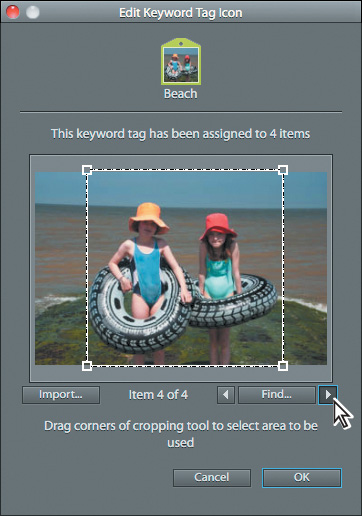
The Find arrows cycle through all photos with the same keyword tag. A small preview at the top of the dialog box shows how each image would look applied as a tag icon.
Choose a new image for the tag icon; then, drag the bounding box on the main preview (and re-size it, if you wish) until you are satisfied with the way it looks in the small tag preview; then click OK to close the dialog box. Click OK again to close the Edit Keyword Tag dialog box.
Changing the hierarchy of categories and keyword tags in the Keyword Tags panel is easy. Doing this will not remove the rearranged tags or categories from the images to which you’ve attached them.
Click the Find box next to the Kids sub-category. A binoculars icon (
 ) appears in the box to remind you that it is now activated. Only the six photos tagged with the Kids keyword are displayed in the Media Browser. Click the Show All button above the Media Browser so that all the images in the catalog are visible.
) appears in the box to remind you that it is now activated. Only the six photos tagged with the Kids keyword are displayed in the Media Browser. Click the Show All button above the Media Browser so that all the images in the catalog are visible.Right-click the Kids sub-category and choose Edit Kids Sub-Category from the context menu. The Edit Sub-Category dialog box appears.
From the Parent Category or Sub-Category menu, choose None (Convert To Category) and click OK.
Now Kids is no longer a sub-category under People, Family but a category in its own right. Its new tag, featuring a stylized portrait icon, has been inherited from its former parent category, People.
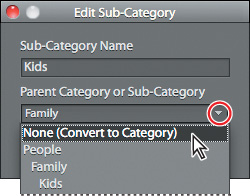
Click the empty Find box beside the Kids category. Notice that the selection of six images tagged with the Kids tag did not change. Move the pointer over the tag icons below any of the images featuring children; note the list of attached keywords. Click the Show All button.
In the Keyword Tags panel, drag the Kids category onto the People category.
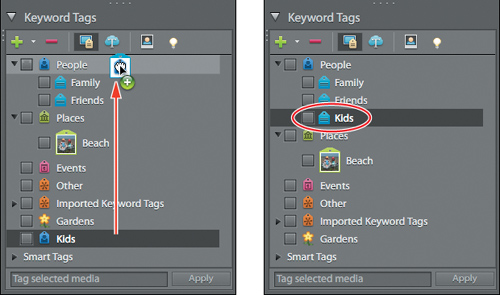
The Kids tag appears as a sub-category once more; this time listed under People. Because it’s no longer a category, its tag reverts to the generic sub-category icon.
Click the empty Find box beside the Kids category; then, move the pointer over the tag icons below any of the images displayed. Neither the selection of images tagged with the Kids keyword nor the list of attached keywords has changed. Click the Show All button.
Under the People category, right-click / Control-click the Family sub-category and choose Change Family Sub-Category To A Keyword Tag from the menu.

In the Media Browser, select the image DSC_1251.jpg (a photo from a visit to Madame Tussaud’s), in preparation for the next exercise.
In Photoshop Elements 9 the Full Screen mode has been improved to give you even more ways to work with keyword tags while reviewing and organizing your photos.
Click the View, Edit, Organize In Full Screen button (
 ) above the Media Browser, or click the Display button (
) above the Media Browser, or click the Display button ( ) at the upper right of the Organizer window and choose View, Edit, Organize In Full Screen from the menu.
) at the upper right of the Organizer window and choose View, Edit, Organize In Full Screen from the menu.Move the pointer over the full screen image to see the control bar at the bottom of the screen. If necessary, click the Pause button, and then click the Toggle Film Strip button or press Ctrl+F on your keyboard so that you can see a strip of thumbnails at the right of the screen as shown below.
Move the pointer to the left edge of the screen, as shown in the illustration below, to show the Quick Organize panel; then, click to deactivate the Auto Hide button at the top of the vertical title bar of the Quick Organize panel so that the panel remains open while you work.
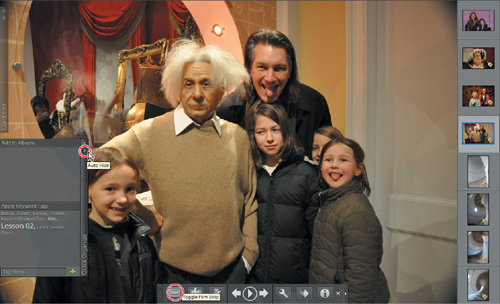
Click in the text box at the bottom of the Quick Organize panel and type Albert; then click the Apply button (
 ) to the right of the text box to attach the new keyword to this image. Move the pointer over the keywords in the Keyword Tags pane of the Quick Organize panel; as you move over each keyword a tooltip message shows that you can click to either apply or remove any of these tags. The keywords already attached to this image are highlighted.
) to the right of the text box to attach the new keyword to this image. Move the pointer over the keywords in the Keyword Tags pane of the Quick Organize panel; as you move over each keyword a tooltip message shows that you can click to either apply or remove any of these tags. The keywords already attached to this image are highlighted.Click to activate the Quick Organize panel’s Auto Hide button once more; then, move the pointer away; the panel closes after a second or so.
Right-click / Control-click the image and choose Show Properties from the menu.
In the Properties panel, click the Keyword Tags tab (
 ) to see the keyword tags attached to this image. Right-click / Control-click the tag Albert and choose Remove Albert Keyword Tag. You’ll explore a better way to tag people later in this chapter. Click the Close button in the header bar to close the Properties panel.
) to see the keyword tags attached to this image. Right-click / Control-click the tag Albert and choose Remove Albert Keyword Tag. You’ll explore a better way to tag people later in this chapter. Click the Close button in the header bar to close the Properties panel.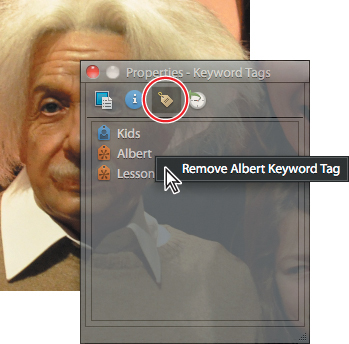
Press the Esc key on your keyboard or click the Close button at the right of the control bar to exit Full Screen mode and return to the thumbnail view.???
The reason for creating, applying and sorting all these keyword tags is so that you can always find just the picture you want, just when you want it—easily and quickly. Once they share a keyword tag, a group of related photos can be retrieved with a single click; no matter how big your catalog, or across how many folders those images are scattered.
Before you go on to have fun with the People Recognition feature, let’s become more familiar with using the Keyword Tags panel to sort and search your files. In the Elements Organizer you now have even more ways to find files by keyword, with enhancements to both the text search feature and the tagging interface.
The most intuitive tool for searching your catalog by keyword is the Keyword Tag Cloud, which displays all the existing tags in your catalog listed in alphabetical order. Varying text sizes indicate the relative number of files tagged with each keyword, which means that those tags that you use most often are the easiest to find at a glance.
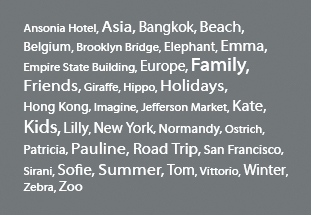
If the Show All button is visible at the top of the Media browser, click it. Click the Keyword Tag Cloud button (
 ) at the top of the Keyword Tags panel.
) at the top of the Keyword Tags panel.In the tag cloud, click Beach; then press Ctrl+A / Command+A to select all four images. Type Vacation in the text box in the header of the Keyword Tags panel and click Apply to attach the new tag to the four images.

Click Show All above the Media Browser. Right-click / Control-click to select the images DSC_1234.jpg, DSC_1247.jpg, DSC_1249.jpg, and DSC_1251.jpg. Drag the tag Vacation from the tag cloud to any one of the selected photos.

Click the keyword Vacation in the tag cloud to see all eight images with this tag displayed in the Media Browser. Click Show All.
You can switch to the hierarchical view of your keyword categories, sub-categories and tags when you want extra organizational control.
In the Keyword Tags panel, click the View Keyword Tag Hierarchy button (
 ).
).In the tag hierarchy, click the empty find box beside the new Vacation tag, in the keyword category Other; the eight images with this keyword show in the Media Browser.
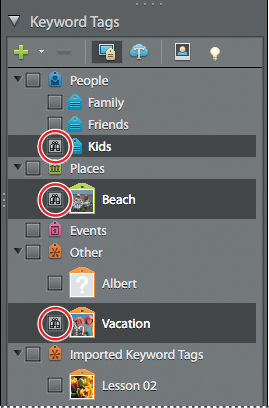
Leaving the Vacation find box active, click the empty find box beside the Kids tag; the display is reduced to the six images that have both of these tags attached. Finally, click the find box beside the tag Beach.
Only four images are returned by the narrowed search. The Find bar above the thumbnails shows that these images have all three keywords: Vacation, Kids and Beach.
From the Options menu in the Find bar above the Media Browser, choose Show Close Match Results.
The thumbnail display is updated to show more photos: images that are tagged with some, but not all of the searched keywords. These close matches can be identified by a check mark icon in the upper left corner of their thumbnails.
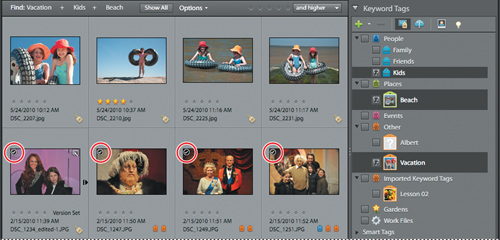
From the Options menu in the Find bar above the Media Browser, choose Hide Close Match Results. Click Show All to display all images. In the Keyword Tags panel, right-click / Control-click the tag Albert and choose Delete Albert Keyword Tag from the context menu. Click OK to confirm the deletion.
Undoubtedly, your growing photo library will include many photos of your family and friends. Photoshop Elements 9 makes it quick and easy to tag your photos of friends and family members with the People Recognition feature, taking most of the work out of sorting and organizing a large portion of your catalog.
The People Recognition feature automatically finds the people in your photos and makes it easy for you to tag them. Once you begin using the feature it learns to recognize the faces you’ve already tagged and will automatically tag new photos that picture the same faces. The more times a particular person is tagged, the better People Recognition will get at recognizing them.
The first experience you’ll have of People Recognition will probably be the “Who Is This?” prompt that appears as you move the pointer over a photo in the single-image view in the Elements Organizer. People Recognition displays these hints to help you identify and tag all the people in your photos. You can ignore the hints if you wish, but remember that the more people you identify, the smarter People Recognition gets at tagging faces for you automatically.
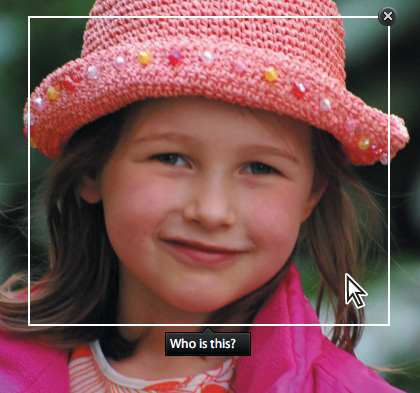
The automatic “Who Is This” hints and the People Recognition feature itself can both be disabled. Before continuing with the exercises in this section, you need to make sure that both are activated. You can also import a few more images with faces for People Recognition to find.
Note
Once People Recognition begins to recognize a particular face, the “Who is this?” hint changes to read “Is this Lilly?,” giving you the opportunity to confirm or cancel automatic tagging.
In the Organizer, choose Preferences > Media-Analysis from the Edit / Adobe Elements 9 Organizer menu. In the Media-Analysis pane of the Preferences dialog box, make sure that the option Analyze Photos For People Automatically is activated. Click OK to save your settings and close the Preferences dialog box.
In the View menu, make sure that Show People Recognition is activated.
Choose File > Get Photos And Videos > From Files And Folders. In the Get Photos And Videos From Files And Folders dialog box, locate and open your Lesson02 folder; then, click once to select the Faces folder. Disable the option Automatically Fix Red Eyes. On Windows, disable the option Automatically Suggest Photo Stacks.
Click Get Media. In the Import Attached Keyword Tags dialog box, click Select All, and then click OK. Click OK to close any other alert dialog box. The Media browser shows only the eight newly imported images.
Above the Media Browser, choose Oldest First for the sorting order.
Photoshop Elements helps you with every step of the face tagging process.
In the Media Browser, double-click the first photo, faces_1.jpg, to see it in the enlarged single image view.
Move the pointer over the image; white boxes appear over any faces detected in the photo. People Recognition has found three of the four faces in this photo. Move the pointer over any of the boxes; the “Who is this?” prompt appears.
Starting with the girl at the left, click the “Who is this?” text in the black box, type the name Pauline, and then press Enter / return. Photoshop Elements creates a new keyword tag for Pauline. By default, the new tag appears in the People category in the Keyword Tags panel. Name the second girl Sophie and the girl on the right Lilly. Be sure to press Enter / return for each tag.
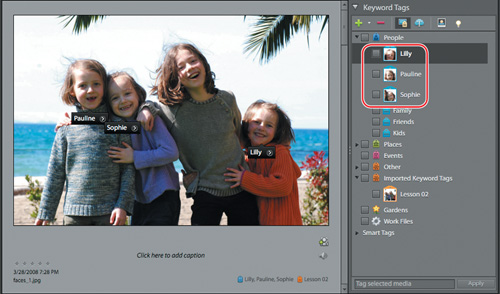
Click the Add Missing Person button (
 ) below the lower right corner of the enlarged image. Drag the new face tagging box onto the face of the taller girl and use the handles around the box to surround her face neatly; then, click the green check mark to confirm the position. Type the name Emma for this girl; then, press Enter / return
) below the lower right corner of the enlarged image. Drag the new face tagging box onto the face of the taller girl and use the handles around the box to surround her face neatly; then, click the green check mark to confirm the position. Type the name Emma for this girl; then, press Enter / returnClick the right arrow key on your keyboard to move on to the next photo. This time, People Recognition has detected all of the faces in the photo.
Click the “Who is this?” text box for the girl at the right of the photo. You haven’t yet tagged enough faces for People Recognition to recognize this girl, but you’re offered a choice of possible tags from those available in the People category. Click the name Sophie, and then press Enter / return.
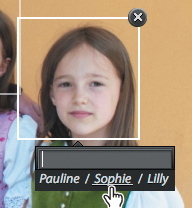
Click the “Who is this?” text box for the girl at the left. This is the same girl that People Recognition failed to find in the first photo, so it doesn’t yet recognize her well enough even to offer the correct choice. Type the name Emma, and then press Enter / return. Type the name Kat to tag her mother.
People Recognition already recognizes the two girls at the center of the photo; click the green check mark to confirm the automatic tagging for Pauline and Lilly.
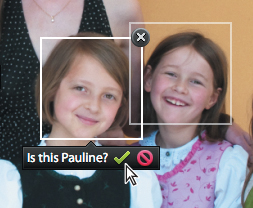
Double-click the image to return the Media Browser to Thumbnail view.
Photoshop Elements helps you with every step of the face tagging process.
Select the six images with faces you have not yet tagged; click the image faces_3.jpg, then Shift-click the image faces_8.jpg.
Click the Start People Recognition button (
 ) in the Keyword Tags panel.
) in the Keyword Tags panel.In the People Recognition - Label People dialog box, tag as many of the faces as you can. (We’ll tell you who that is later.) Be sure to press Enter / return whenever you type. When you’re done, click Save. A new set of faces appear.

Tag the new set of faces. The name of the girls’ father is Tom. Click Save.
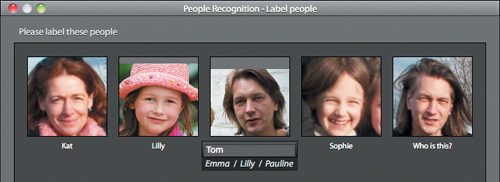
Continue tagging the faces presented in the People Recognition - Label People dialog box and saving each set, until People Recognition displays the image that you see in the illustration at the right.
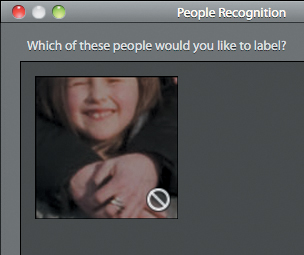
People Recognition will sometimes incorrectly identify a chance arrangement of light and shadow in an image as a face. When this happens, you’ll be asked whether you’d like to label the “person” or not. If you clicked on this image, you would be confirming it as a face that you know; you would then be returned to the Label People dialog box to tag it. If you clicked Save, ignoring this image, People Recognition would no longer see it as a face. For the purposes of this exercise, click Cancel to return to the Media Browser; we’ll deal with this case in a different way.
In the Media Browser, double-click the photo faces_6.jpg to see the image enlarged in the single image view. Move the pointer over the image; you’ll see the extraneous tagging box framing the lower half of Lilly’s face and her mother’s hands.
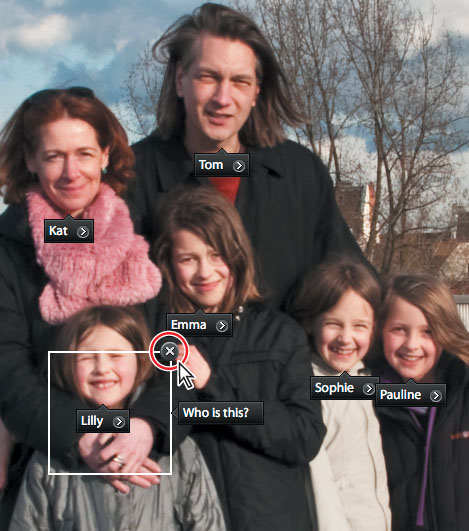
Click the X button at the upper right corner of the tagging box to dismiss it; otherwise People Recognition will register this as a person not yet named. If you see an alert asking you to confirm the exclusion from People Recognition; click Yes.
Double-click the photo to return the Media Browser to Thumbnail view. In the keywords panel, activate the Find box beside the each of your new tags in turn, making sure to disable one Find box before clicking the next. Now try activating different combinations and numbers of Find boxes at once. The details of each search are shown in the Find bar above the thumbnail display.
Click Show All, if it’s visible above the Media Browser. Choose Edit > Select All; then, click the Start People Recognition button (
 ) in the Keyword Tags panel to run the tagging process once more for your entire Lesson2 catalog. People recognition searches the selected images for faces it knows, and presents you with as many as possible arranged in groups in the People Recognition - Confirm Groups Of People dialog box. In this case, all of the grouped faces have been correctly identified, but if you wish to exclude a face, move the pointer over the thumbnail and click the X button in the upper right corner of its bounding box.
) in the Keyword Tags panel to run the tagging process once more for your entire Lesson2 catalog. People recognition searches the selected images for faces it knows, and presents you with as many as possible arranged in groups in the People Recognition - Confirm Groups Of People dialog box. In this case, all of the grouped faces have been correctly identified, but if you wish to exclude a face, move the pointer over the thumbnail and click the X button in the upper right corner of its bounding box.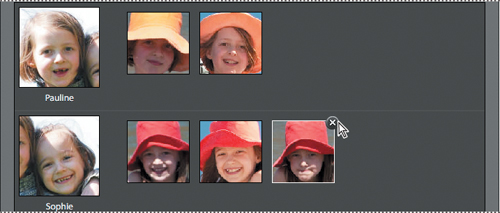
Click Save and continue with the process; you still have a few un-tagged friends.

For more information on People Recognition, as well as other aspects of the Auto-Analysis feature including Smart Tags, please refer to Adobe Photoshop Elements Help.
Congratulations, you’ve finished the lesson! You’ve imported files into the Elements Organizer using a variety of new techniques and learned several different ways to view and access the images in your catalog. You’ve also created, edited, and applied keyword tags to individual photographs so that they’ll be easy to find in future.
Before you move on, take a few moments to review the concepts and techniques presented in this lesson by working through the following questions and answers.

